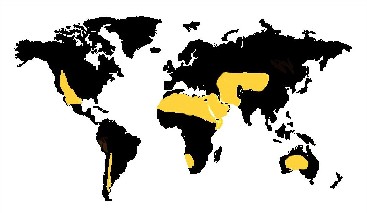What is the biosphere?
The planet Earth is unique, and - as far as we know - is the only place in the universe that can support living entities. The global envelope supporting life, along with the organisms it contains, is known as the biosphere (from the Greek bios, life; and sphaira, ball). Although the biosphere's maximum thickness is some 21 km., this living mantle around the Earth is extremely thin when compared to the 6,370-km. radius of our planet. In fact, most living species, which amount to about 1.5 million, live in a much more restricted shell of the planet, where the temperature range is much more moderate. Organisms living in this expanse depend on the availability of energy and water. In equatorial regions, where both these factors are high, the mass of living species - their biomass - is at a maximum.
What are the biomes?
The biosphere is subdivided into specific regions - or biomes - whose essential characteristics differ from one another. A biome is composed of a complex of vegetative associations, animal life and microorganisms, which is stabilized by a particular climate and characterized by a typical vegetative structure. The organisms living in any particular biome exhibit specialized adaptations that enable them to live under the region's specific conditions. Examples of land-based biomes include: deserts, tundras, savannas, tropical rain forests, temperate deciduous forests, boreal needleleaf forests (taigas), etc. Oceans and fresh-water lakes are yet other biomes.
The desert biome
The desert biome is characterized by readily available, highly concentrated solar energy, but has sparsely available water. The hot, "desolate" desert biome is home to many forms of life - plants, animals and microorganisms that have developed specializations preventing them from losing water, enabling them to store it, and providing them with mechanisms for controlling their body temperatures. Deserts cover about a fifth of the world's continental areas and are depicted in the map in Fig. 1.
|

|
|
|
Figure 1. World map showing the desert biomes (yellow areas). These account for nearly one fifth of the continental surface.
|
Drylands are characterized by aridity, as shown by their thin natural vegetation and their limited usefulness to farmers raising field crops. International organizations generally divide dry regions into four categories: hyperarid, arid, semi-arid, and dry sub-humid. These levels are defined quantitatively according to their average annual precipitation or an aridity index, the latter factor including not only the positive contribution of precipitation, but also water losses due to evaporation and transpiration (evapotranspiration). Thus, for example, a hyperarid region will have an annual precipitation range between 0 and 50 mm., or an aridity index between 0 and 0.3.
Man in the desert
The desert expanses throughout the world are intimately linked to human culture, history and experience. Throughout history, prophets and monastics of various religions went into the desert for solitude and divine inspiration. Desert cultures developed broad-based agriculture thanks to impressive methods for collecting water, and many historic routes of trade and conquest passed through desert areas, with settlements that flourished along their paths.
Desert regions are characterized by restricted water resources, sparse vegetation and large temperature differences between day and night, among other distinctive features. Residents of these areas were therefore obliged to adjust their lifestyles to conform to these conditions. But these human accommodations were not always friendly to the environment, and the unfettered exploitation of natural resources by man, usually accompanied by climatic change, brought on desertification.
Previous section Next section